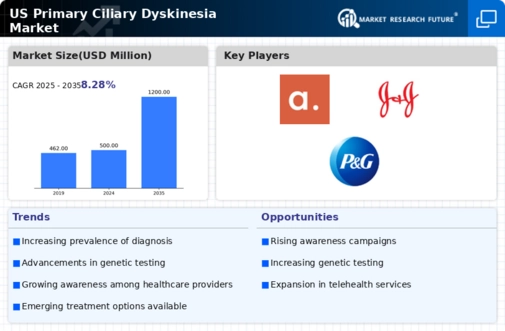Increased Research Funding
The surge in research funding dedicated to rare diseases, including primary ciliary dyskinesia, is likely to bolster the market significantly. Government and private organizations are increasingly recognizing the need for research into rare genetic disorders, which has led to a rise in grants and financial support. In the US, funding for rare disease research has seen an increase of over 20% in recent years, which may enhance the understanding of primary ciliary dyskinesia and lead to the development of novel therapies. This influx of funding could stimulate innovation within the primary ciliary-dyskinesia market, potentially resulting in new treatment options and improved patient care. As research progresses, it may also attract more pharmaceutical companies to invest in this niche area, further expanding the market.
Emerging Therapeutic Options
The development of new therapeutic options for primary ciliary dyskinesia is poised to reshape the market landscape. Recent advancements in drug development, including gene therapy and personalized medicine, hold promise for more effective treatments. As pharmaceutical companies invest in research and development, the primary ciliary-dyskinesia market may witness the introduction of innovative therapies that target the underlying causes of the condition. The market for rare disease therapies is projected to grow significantly, with estimates suggesting a value of over $200 billion by 2025. This growth indicates a strong interest in addressing unmet medical needs, which could lead to a wider array of treatment options for patients with primary ciliary dyskinesia. As these therapies become available, they may enhance patient outcomes and drive market expansion.
Rising Incidence of Respiratory Disorders
The increasing prevalence of respiratory disorders in the US appears to be a significant driver for the primary ciliary-dyskinesia market. Studies indicate that respiratory issues, including chronic bronchitis and asthma, are on the rise, affecting millions. This trend may lead to heightened awareness and diagnosis of underlying conditions such as primary ciliary dyskinesia, which is often misdiagnosed. As healthcare providers become more vigilant in identifying these disorders, the demand for diagnostic tests and treatments is likely to increase. Furthermore, the market for respiratory therapies is projected to reach approximately $30 billion by 2026, suggesting a growing investment in related healthcare solutions. This rising incidence not only emphasizes the need for effective management strategies but also propels the primary ciliary-dyskinesia market forward, as patients seek specialized care.
Technological Advancements in Diagnostics
Technological innovations in diagnostic tools are transforming the landscape of the primary ciliary-dyskinesia market. Enhanced imaging techniques and genetic testing methods are becoming more accessible, allowing for earlier and more accurate diagnosis of the condition. For instance, advancements in high-resolution computed tomography (HRCT) and next-generation sequencing (NGS) are enabling healthcare professionals to identify ciliary dysfunction more effectively. The market for diagnostic devices is expected to grow at a CAGR of around 8% through 2027, indicating a robust demand for improved diagnostic solutions. As these technologies evolve, they may facilitate better patient outcomes and increase the overall market size for primary ciliary-dyskinesia, as timely diagnosis is crucial for effective management.
Growing Patient Advocacy and Support Groups
The emergence of patient advocacy groups dedicated to primary ciliary dyskinesia is fostering a supportive environment for affected individuals and their families. These organizations play a crucial role in raising awareness, providing resources, and advocating for better healthcare policies. Their efforts may lead to increased visibility of the condition, encouraging more patients to seek diagnosis and treatment. As awareness grows, the primary ciliary-dyskinesia market could experience a corresponding increase in demand for therapies and support services. Furthermore, these groups often collaborate with healthcare providers and researchers, potentially accelerating the development of new treatment options. The influence of patient advocacy is becoming increasingly evident, as it empowers patients and drives progress within the market.














Leave a Comment